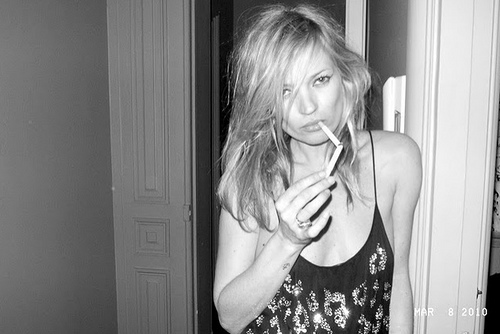By Leanna Pankratz (The Cascade) – Email
Print Edition: March 7, 2012
It all started with a few Vincent Gallo-shot Calvin Klein ads in the ‘90s featuring then upstart young model Kate Moss. For a fashion world accustomed to the 1980s supermodel era featuring voluptuous, vibrant specimens like Cindy Crawford and Linda Evangelista, these ads were a step in a new direction. Stripping the model and the clothes completely of any implied glamour, heroin chic was characterized by a messy, gin-soaked, slightly scruffy presentation. The look suggested an element of self-destruction – a pale, bone-jutting, sunken eye kind of glamour that implicated a certain world-weariness. It was a kind of sad, smoke-blowing, unexpected beauty.
Cited by the Los Angeles Times as a “nihilistic vision of beauty,” heroin-chic was arguably a launching pad for the fashion world’s leap into more experimental territory – the desire for something innovate, something interesting, rather than traditionally beautiful.
The concept of something as serious as drug use being glamourized in fashion is what has drawn many an evil eye again this trend. “I’m certain there’s very few people who admire the heroin-chic look that actually want to do heroin, explained Natalia Giacchi, a Vancouver fashion intern and merchandising graduate. “It’s more of a revolt against traditional standards of beauty, or the suggestion that all beautiful women must be a C-cup. Kate Moss had hipbones, she had ribs. It was a different body type that before would have been considered waifish or boyish. It was new.”
“Heroin chic began as fashion rebellion,” she continued, “it was hardcore for its time, and pretty much epitomizes the spirit of grungy, wasted techno parties.” Fashion rebellion is a good way to put it. Photographer Davide Sorrenti utilized the heroin-chic ideal during the ‘90s in his photographs that featured run-down environments and strung out, glassy-eyed models. It was a glorification of all things dilapidated and decayed, it was something new, and the fashion world completely lapped it up.
Heroin chic has seen a bit of resurgence nowadays, but it is still a far cry from the authentic revolution that it was in the early to mid ‘90s. We’ve seen it in the merging of the unexpected this last season, in the minimalist, stripped-down visions from designers who’ve previously only shot in colour. The waifish, far-eyed look has come back a bit in fashion photography, as has the importance placed on being different or groundbreaking as opposed to being cookie-cutter gorgeous. Kate Moss herself has made somewhat of a return to the catwalk, most notably strutting in Louis Vuitton’s fall collection donning black leather and puffing irreverently on a cigarette, not a wink or smile in sight. That image of boldness, or fashion impertinence, is the spirit that pervaded heroin chic upon its conception, and has continued to shock, infuriate, and inspire. More a commentary on the current world and rampant disillusionment, heroin-chic has lived up to its name as fashion nihilism – suggesting a space where the only thing to do sometimes is dance away in a run-down nightclub, purposely disheveled hair and smudgy eyeliner intentionally mussed. In a world rife with tribulations, sometimes all we can do is put our game face on and make something beautiful out of the grime.


